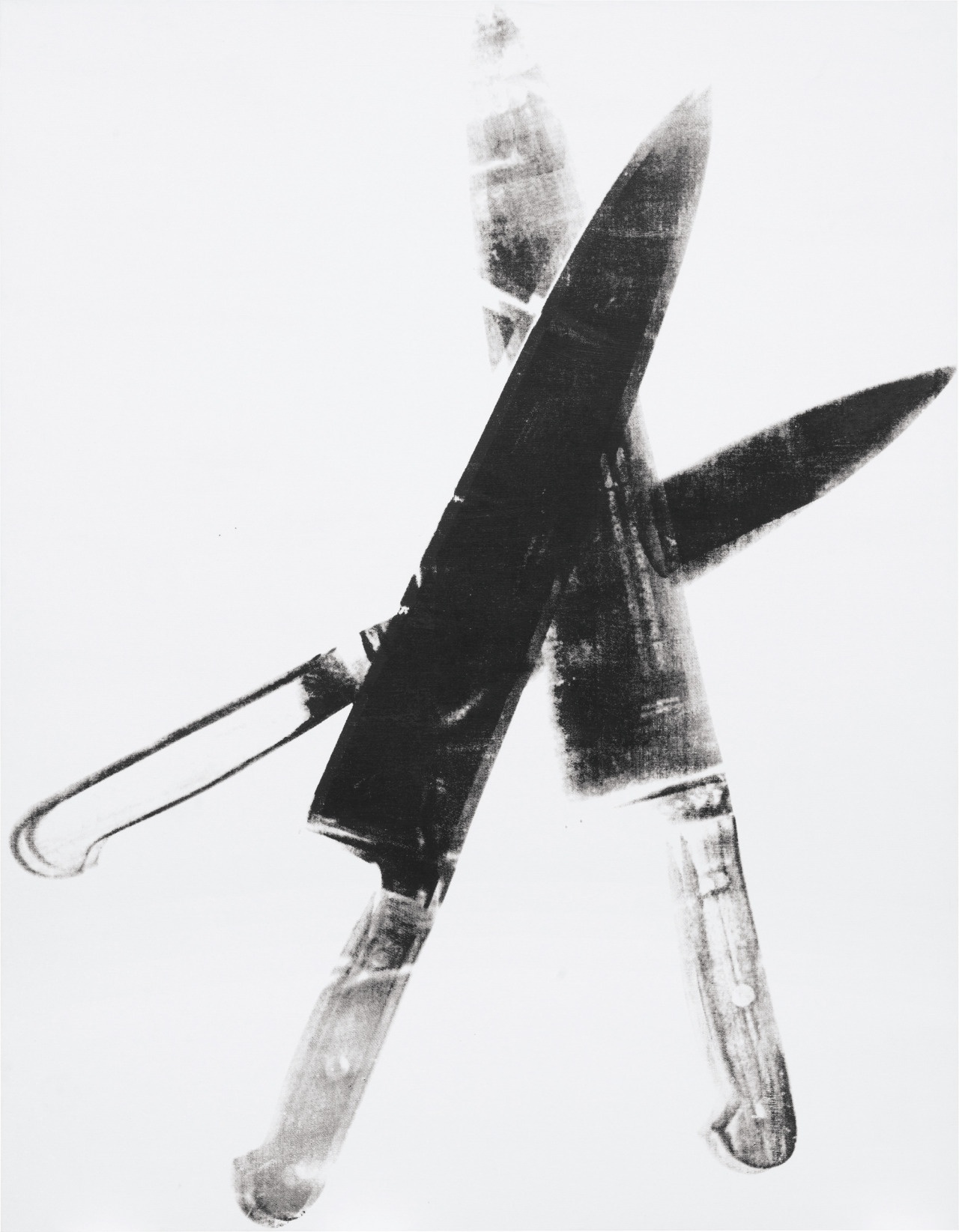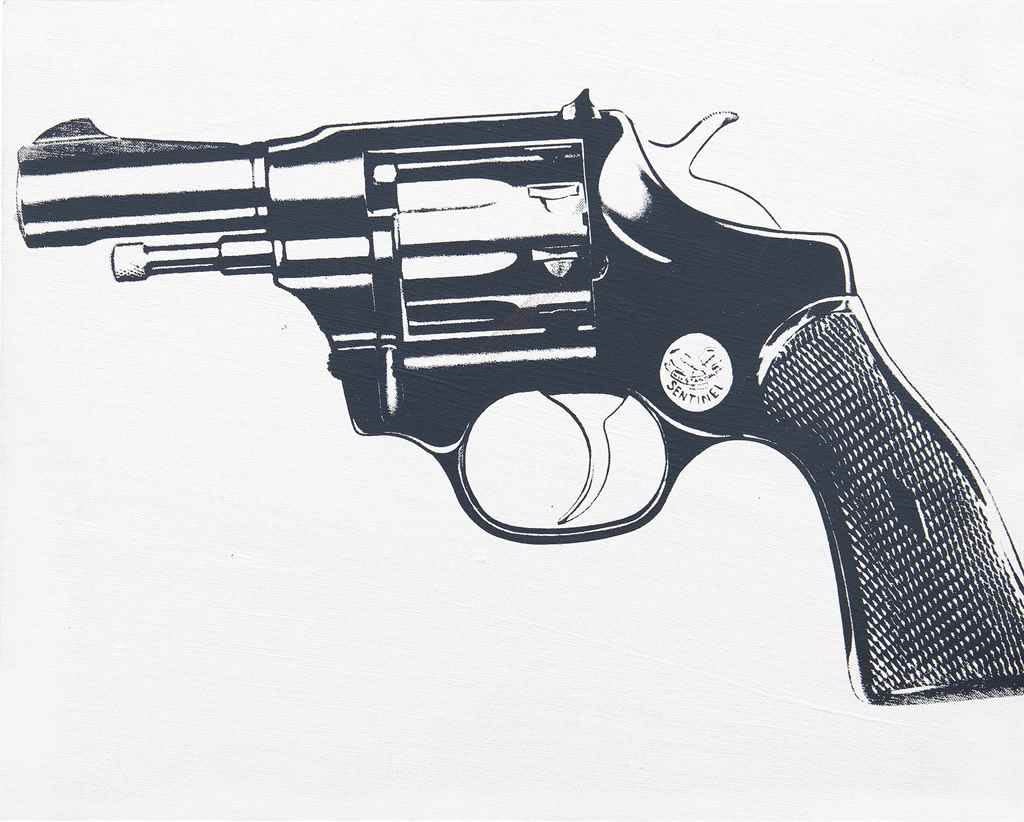Andy Warhol further pushed the boundaries of artistic expression with his late paintings from the mid-1980s. Departing from his iconic pop art style, Warhol embarked on a journey of introspection and experimentation, exploring themes relating to the injustices of war, religious symbolism, personal identity, and mortality. Through a series of striking black-and-white paintings inspired by hand-drawn ads of the 1950s, Warhol confronted the complexities of the human experience with boldness and nuance. These late works, characterized by their stark imagery and profound symbolism, offer a captivating glimpse into the mind of an artist at the height of his creative powers, challenging viewers to engage with the pressing issues of their time and the enduring mysteries of existence.
ANDY WARHOL'S MAP OF THE EASTERN U.S.S.R. FROM 1985-86 SERVES AS A STARK RESPONSE TO THE ESCALATING TENSIONS BETWEEN THE UNITED STATES AND THE USSR DURING THE COLD WAR ERA. THE PIECE, RENDERED IN BLACK AND WHITE POLYMER ON A WHITE CANVAS, DEPICTS A MAP OF MISSILE BASES FOR A POTENTIAL NUCLEAR ATTACK. THIS CHOICE OF SUBJECT MATTER HIGHLIGHTS THE GRIM REALITY OF DÉTENTE AND THE LOOMING THREAT OF NUCLEAR ANNIHILATION THAT HUNG OVER THE WORLD AT THE TIME. THE BLACK AND WHITE COLOR SCHEME EVOKES WINTRY DESOLATION, REMINISCENT OF THE DESERTS OF THE SOVIET UNION DURING THE COLD SEASON, INTENSIFYING THE OMINOUS MOOD OF THE PIECE. DESPITE ITS ORIGINS AS A CLIPPING FROM A MAGAZINE OR NEWSPAPER, THE WORK'S FEEL IS MORE ALIGNED WITH THE 1960S THAN THE 1980S, SUGGESTING THAT
WARHOL MAINTAINED A COLLECTION OF CLIPPINGS THROUGHOUT THE YEARS, STRATEGICALLY USING ONE NEARLY TWO DECADES LATER FOR EXPLICIT PURPOSES OF CREATION.
In
WARHOL's The Mark of the Beast, created during the 1980s, he delves into themes of war, death, and religion within the context of the Cold War. The diptych features silk-screened black-and-white canvases depicting the biblical imagery of 666, a symbol associated with the anti-Christ. This motif reflects Warhol's own Catholic upbringing and spiritual anxieties, offering a contemplative exploration of themes related to faith and existential dread. The opposing sides of the diptych, presented in positive and negative versions, can be interpreted as echoing the Cold War conflict, further adding layers of complexity to the piece's symbolism.
Are You Different? is a thought-provoking piece by
Warhol that encapsulates his exploration of identity, consumerism, and mass culture. This work, created with light radiating from a star on the figure's forehead and accompanied by a soul-searching question, suggests
Warhol's personal insecurities about appearance and his desire to fit in. The ambiguity of the question invites multiple interpretations, prompting viewers to reflect on their sense of individuality and the influences of consumer culture on their identities. This piece, while clearly spiritual in nature, was never shown during
Warhol's lifetime, underscoring the private nature of his religious beliefs and personal reflections.

Warhol's Knives, produced in 1981-82, represents his fascination with transforming everyday objects into images suggestive of the violent and macabre underside of American culture. This series of paintings and drawings features the kitchen knife as its subject, powerful in its potential as a utilitarian tool for anything from cooking to murder.
Warhol's use of black, white, and silver in his signature palette creates patterns of light and dark reflections through his silkscreen technique, imbuing the works with an ambiguous, malevolent presence. The knives, depicted as ghostly apparitions, transcend their utilitarian function and evoke themes of mortality and violence, serving as a form of memento mori that challenges viewers to confront the darker aspects of human existence.

Warhol's exploration of guns in his late paintings serves as a chilling reminder of his own brush with violence in 1968, when he survived an assassination attempt. These works, produced with cold, harsh edges and devoid of emotion, symbolize power, authority, and the potential for violence.
Warhol's decision to portray guns in a realistic manner, without the bold, tonal colors typical of his earlier works, underscores the inherent phallocratic nature of the weapon and its association with masculinity and aggression. By depicting guns in this manner,
Warhol confronts viewers with the stark reality of violence and the pervasive influence of firearms in American society, serving as a poignant commentary on power, ownership, and authority.
Andy
Warhol's late paintings from the mid-1980s represent a profound exploration of cultural, personal, and existential themes, reflecting the artist's enduring fascination with the human condition. Through works such as Map of the Eastern U.S.S.R., The Mark of the Beast, Are You Different?, Knives, and Guns,
Warhol delves into topics ranging from the Cold War and religious symbolism to identity, consumerism, and violence. These late paintings serve as a testament to
Warhol's versatility as an artist and his ability to capture the zeitgeist of his time with striking visual presence and compelling content. Each piece invites viewers to contemplate the complexities of the human experience, offering a glimpse into
Warhol's multifaceted artistic vision and his uncanny ability to provoke thought and introspection. Through his late paintings,
Warhol leaves behind a powerful legacy that continues to resonate with audiences today, challenging us to confront the realities of our world and our place within it.
May 28, 2024



